Universe Today | Nancy Atkinson | 2011 Jan 19
A small solar sail that was thought to be a lost cause has “spontaneously” come back to life. The NanoSail-D — a NASA-designed solar sail cubesat that launched in December but suddenly went silent without confirmation of its deployment — unexpectedly ejected from its host satellite on Wednesday, Jan. 19 at 11:30 a.m. EST. Engineers at Marshall Space Flight Center confirmed that the NanoSail-D nanosatellite ejected from Fast Affordable Scientific and Technology Satellite, FASTSAT, when they looked at onboard FASTSAT telemetry. The ejection of NanoSail-D also has been confirmed by ground-based satellite tracking.
Now NASA is asking for help from ham radio operators to listen for the signal to verify NanoSail-D is operating. And knowing the status of the solar sail is time critical.
“This is great news for our team. We’re anxious to hear the beacon which tells us that NanoSail-D is healthy and operating as planned,” said Dean Alhorn, NanoSail-D principal investigator and aerospace engineer at the Marshall Center. “The science team is hopeful to see that NanoSail-D is operational and will be able to unfurl its solar sail.”
If you are a ham operator, This information should be sent to the NanoSail-D dashboard at: http://nanosaild.engr.scu.edu/dashboard.htm. The NanoSail-D beacon signal can be found at 437.270 MHz.
NanoSail-D was designed to test the potential for solar sails in atmospheric braking. On December 6, 2010, it was schedule to eject from the FASTSAT, and initially it looked as though it did. But later, ground controllers were unable to confirm if the solar sail had ejected or deployed. Further analysis showed no evidence of NanoSail-D in low-Earth orbit, leading the team to believe NanoSail-D remained inside FASTSAT.
Now, with this latest news that the loaf-of-bread-sized satellite has ejected on its own, the NanoSail-D science team is hopeful the nanosatellite is healthy and can complete its solar sail mission. But the sequence of events are time critical.
After ejection, a timer within NanoSail-D begins a three-day countdown as the satellite orbits the Earth. Once the timer reaches zero, four booms will quickly deploy and the NanoSail-D sail will start to unfold to a 100-square-foot polymer sail. Within five seconds the sail fully unfurls.
“We knew that the door opened and it was possible that NanoSail-D could eject on its own,” said Mark Boudreaux, FASTSAT project manager at the Marshall Center. “What a pleasant surprise this morning when our flight operations team confirmed that NanoSail-D is now a free flyer.”
If the deployment is successful, NanoSail-D will stay in low-Earth orbit between 70 and 120 days, depending on atmospheric conditions. NanoSail-D is designed to demonstrate deployment of a compact solar sail boom system that could lead to further development of this alternative solar sail propulsion technology and FASTSAT’s ability to eject a nano-satellite from a micro-satellite — while avoiding re-contact with the FASTSAT satellite bus.
Source: Marshall Space Flight Center



